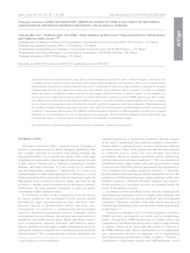Schinopsis brasiliensis bark metabolomic profiling based on nmr: evaluation of metabolic variations of different microenvironment and seasonal periods.
Schinopsis brasiliensis bark metabolomic profiling based on nmr: evaluation of metabolic variations of different microenvironment and seasonal periods.
Autoria: LUZ, L. dos R.; ALVES FILHO, E. G.; SOARES, M. M. da S.; PORTO, D. D.; BECKER, H.; ZOCOLO, G. J.
Resumo: Schinopsis brasiliensis Engl. (braúna) is a tree species of the Anacardiaceae family. It is native to Brazil, Paraguay, and Bolivia. It is a candidate for agro-industrial system that can be used to produce phytotherapeutics and bioproducts. However, to comprehensively understand the characteristics of plant within the framework of sustainable development for agro-industries, exploring the chemical and phenotypic diversity of samples from various microenvironments across different collection periods is essential. Accordingly, herein, the influence of different environmental factors and sample collection durations on braúna samples was investigated over several years using multivariate statistical analyses associated with nuclear magnetic resonance (NMR) spectroscopy. Bark samples rom different areas and environmental data from different locations were analyzed. Distinct chemical profiles were observed across reserve, forest, and management areas, all marked by elevated sugar levels suggesting water stress adaptation. High radiation and low rainfall correlated with increased sugar and amino acids. Each microenvironment responded uniquely to these environmental conditions. Consequently, plant samples from different microenvironments collected over different periods were observed to respond differently to environmental factors, such as solar radiation and temperature. We correlated the metabolomic data with climatic data evaluating the influence of abiotic factors on the production of metabolites in braúna bark samples.
Ano de publicação: 2024
Tipo de publicação: Artigo de periódico
Unidade: Embrapa Semiárido
Observações
1 - Por padrão são exibidas publicações dos últimos 20 anos. Para encontrar publicações mais antigas, configure o filtro ano de publicação, colocando o ano a partir do qual você deseja encontrar publicações. O filtro está na coluna da esquerda na busca acima.
2 - Para ler algumas publicações da Embrapa (apenas as que estão em formato ePub), é necessário ter, no celular ou computador, um desses softwares gratuitos. Sistemas Android: Google Play Livros; IOS: iBooks; Windows e Linux: software Calibre.
Acesse outras publicações
Acesse a Base de Dados da Pesquisa Agropecuária (BDPA) para consultar o acervo completo das bibliotecas da Embrapa.

